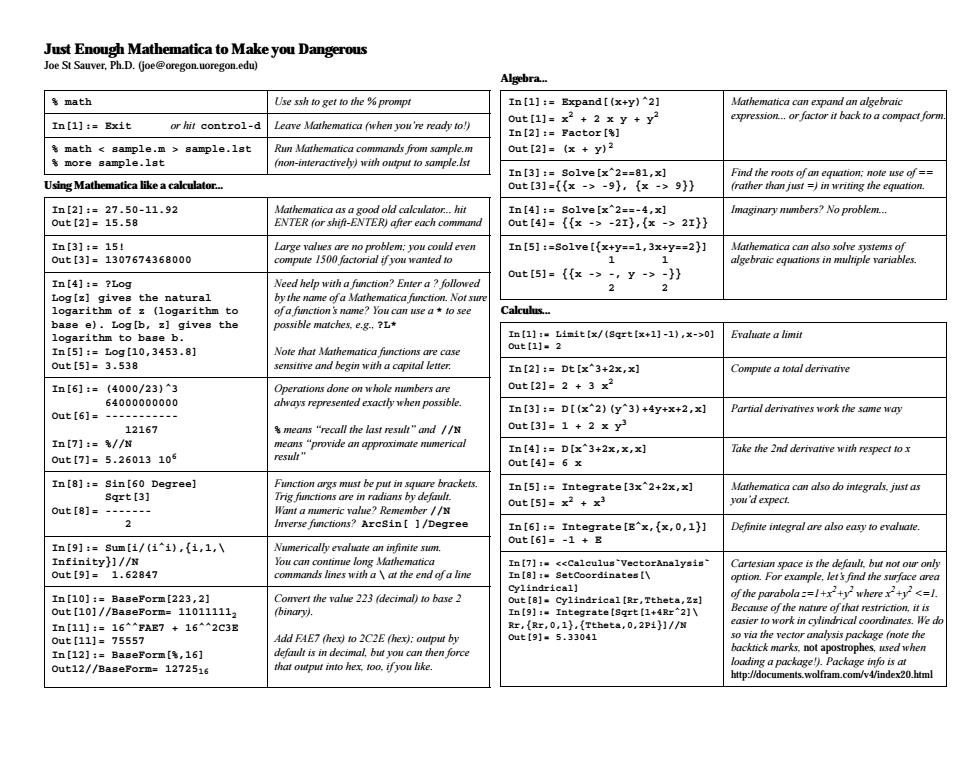正在加载图片...

Just Enough Mathematica to Make you Dangerous Joe St Sauver,Ph.D.(joe@oregon.uoregon.edu) Algebra. math Use ssh to get to the %prompt In[1]:=Expand[(x+y)2] Mathematica can expand an algebraic or hit control-d Leave Mathematica (when you're ready to!) out[1]=x2+2 x y+y expression...or factor it back to a compact for In[1]:=Exit In[2]:=Factor[&] &math sample.m sample.1st Run Mathematica commands from sample.m out[21=(x+y)2 考more8 ample.lat (non-interactively)with output to sample.Ist In[3]:Solve[x2=-81,x] Find the roots of an equation: note use of== Using Mathematica like a calculator.. out [3]={{x -9},{x->9}】 (rather than just)in writing the equation. 1n[21:=27.50-11.92 Mathematica as a good old calculator..hit In[41:=so1ve[x2==-4,x] Imaginary numbers?No problem.. 0ut[21=15.58 ENTER (or shift-ENTER)afer each comman out[41=({x--2I},(x->2r}】 In[3]:=151 Large value. sare no problem:you could even In[5]:=so1ve[{x+y=1,3x+y=2}] Mathematica can also solve systems of 0ut[3]=1307674368000 compute 1500 factorial if you wanted to 1 algebraic equations in multiple variables 1n[41:=2Log out[51={x->-,y->-} 2 atica fuction.No 2 name?Y u can use a lo see Calculus. base e).Log [b,zl gives the possible matches,e.g..?* logarithm to base b. In[1]:Limit [x/(sqrt [x+1]-1),x-0] Evaluate alimit 0ut111=2 In[5]:=Log[10,3453.8] Note that Mathematica functions are case out[5]=3.538 sensinive and begin with a capital lener. In[2]:=Dt[x3+2x,x] Compute a total derivative 1n[6]:=(4000/23)^3 Operations done on whole numbers are 0ut[2]=2+3x 64000000000 ahways represented exactly when possible. 0ut[61=-------- In[3]:=D[(x2)(y^3)+4y+x+2,x] Partial derivatives work the same way 12167 是neans“ecall the last result"and//N out [3]=1 2 x y3 In[7]:=//N means"provide an approximate numerical In[4]:=D[x^3+2x,x,x] 0ut[71=5.2601310 result' Take the 2nd derivative with respect to x out [4]=6 x In[8]:=sin[60 Degree] uare brackets In[5]:=Integrate[3x2+2x,x] Math ematica can also do integrals.just as Sqrt[3] you'd expect. out [8]= ralue?Remember//8 0ut[5]=x2+x3 Arcsin【/Degree In[6]:=Integrate [E'x,{x,0,1)] Definite integral are also easy to evaluate. 0ut[6]=-1+B In[9]:=sum[i/(i◆1),{1,1,\ Numerically evaluate an infinite sim. Infinity}]//N In[7]:.ccCalculus'VectorAnalysis" 1.62847 commands lines with a at the end of a line In[8]:-Setcoordinates[\ space ihe Out[9]= option.For example.lets the st Culindricall In[101:=Ba8 eForm[223,2] Convert the value 223 (decimal)to base 2 of the narabala=ltrtv where rty < Out [8]-Cylindrical [Rr,Ttheta,Zz] 0ut[10]//Ba8 eForm=11011111 (binary以. In【9]:。Integrate[sgrt[1+4Rr^2]\N Because of the nature of that restriction,it is In[11]:=16*FAE7+162C3E Rr,(Rr,0.1).{Ttheta,0.2Pi)]//N easier to work in cvlindrical co rdinates..形ed 0ut[11J=75557 Add FAE7 (hex)to 2C2E (hex):output by 0ut[95.33041 (note the d wh n[12 BaseForm[&,16] defandt is in decimal,but you can then force kota t12//BaseForm=1272516 that ouput into hex.too.if you like. age Package http://documents.wolfram.com/v4/index20.html Just Enough Mathematica to Make you Dangerous Joe St Sauver, Ph.D. (joe@oregon.uoregon.edu) % math Use ssh to get to the % prompt In[1]:= Exit or hit control-d Leave Mathematica (when you’re ready to!) % math < sample.m > sample.lst % more sample.lst Run Mathematica commands from sample.m (non-interactively) with output to sample.lst Using Mathematica like a calculator... In[2]:= 27.50-11.92 Out[2]= 15.58 Mathematica as a good old calculator... hit ENTER (or shift-ENTER) after each command In[3]:= 15! Out[3]= 1307674368000 Large values are no problem; you could even compute 1500 factorial if you wanted to In[4]:= ?Log Log[z] gives the natural logarithm of z (logarithm to base e). Log[b, z] gives the logarithm to base b. In[5]:= Log[10,3453.8] Out[5]= 3.538 Need help with a function? Enter a ? followed by the name of a Mathematica function. Not sure of a function’s name? You can use a * to see possible matches, e.g., ?L* Note that Mathematica functions are case sensitive and begin with a capital letter. In[6]:= (4000/23)^3 64000000000 Out[6]= ----------- 12167 In[7]:= %//N Out[7]= 5.26013 106 Operations done on whole numbers are always represented exactly when possible. % means “recall the last result” and //N means “provide an approximate numerical result” In[8]:= Sin[60 Degree] Sqrt[3] Out[8]= ------- 2 Function args must be put in square brackets. Trig functions are in radians by default. Want a numeric value? Remember //N Inverse functions? ArcSin[ ]/Degree In[9]:= Sum[i/(i^i),{i,1,\ Infinity}]//N Out[9]= 1.62847 Numerically evaluate an infinite sum. You can continue long Mathematica commands lines with a \ at the end of a line In[10]:= BaseForm[223,2] Out[10]//BaseForm= 110111112 In[11]:= 16^^FAE7 + 16^^2C3E Out[11]= 75557 In[12]:= BaseForm[%,16] Out12//BaseForm= 1272516 Convert the value 223 (decimal) to base 2 (binary). Add FAE7 (hex) to 2C2E (hex); output by default is in decimal, but you can then force that output into hex, too, if you like. Algebra... In[1]:= Expand[(x+y)^2] Out[1]= x2 + 2 x y + y2 In[2]:= Factor[%] Out[2]= (x + y)2 Mathematica can expand an algebraic expression... or factor it back to a compact form. In[3]:= Solve[x^2==81,x] Out[3]={{x -> -9}, {x -> 9}} Find the roots of an equation; note use of == (rather than just =) in writing the equation. In[4]:= Solve[x^2==-4,x] Out[4]= {{x -> -2I},{x -> 2I}} Imaginary numbers? No problem... In[5]:=Solve[{x+y==1,3x+y==2}] 1 1 Out[5]= {{x -> -, y -> -}} 2 2 Mathematica can also solve systems of algebraic equations in multiple variables. Calculus... In[1]:= Limit[x/(Sqrt[x+1]-1),x->0] Out[1]= 2 Evaluate a limit In[2]:= Dt[x^3+2x,x] Out[2]= 2 + 3 x2 Compute a total derivative In[3]:= D[(x^2)(y^3)+4y+x+2,x] Out[3]= 1 + 2 x y3 Partial derivatives work the same way In[4]:= D[x^3+2x,x,x] Out[4]= 6 x Take the 2nd derivative with respect to x In[5]:= Integrate[3x^2+2x,x] Out[5]= x2 + x3 Mathematica can also do integrals, just as you’d expect. In[6]:= Integrate[E^x,{x,0,1}] Out[6]= -1 + E Definite integral are also easy to evaluate. In[7]:= <<Calculus`VectorAnalysis` In[8]:= SetCoordinates[\ Cylindrical] Out[8]= Cylindrical[Rr,Ttheta,Zz] In[9]:= Integrate[Sqrt[1+4Rr^2]\ Rr,{Rr,0,1},{Ttheta,0,2Pi}]//N Out[9]= 5.33041 Cartesian space is the default, but not our only option. For example, let’s find the surface area of the parabola z=1+x2 +y2 where x2 +y2 <=1. Because of the nature of that restriction, it is easier to work in cylindrical coordinates. We do so via the vector analysis package (note the backtick marks, not apostrophes, used when loading a package!). Package info is at http://documents.wolfram.com/v4/index20.html